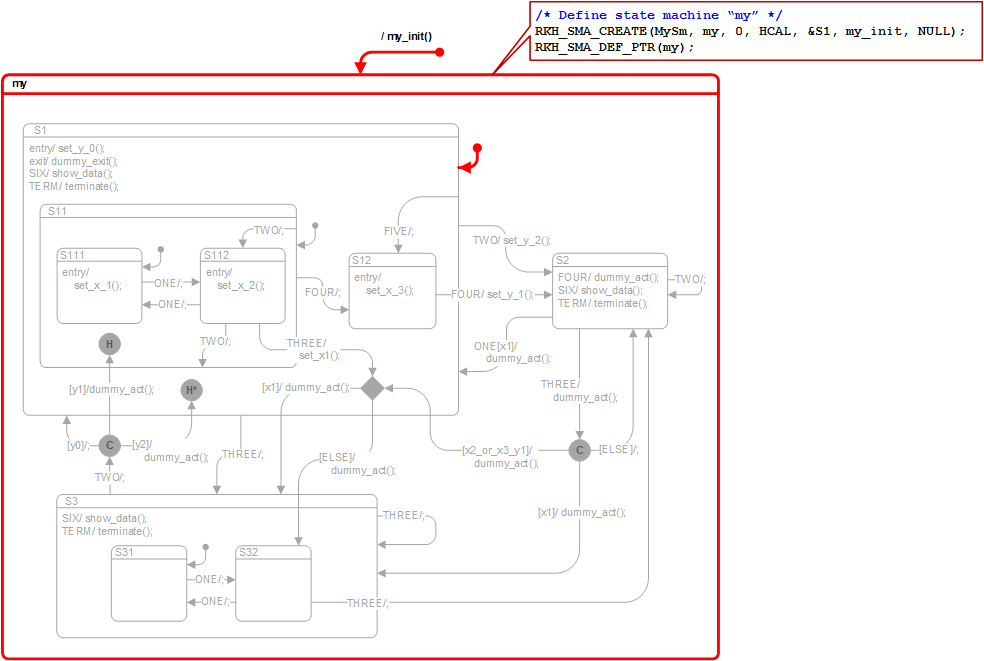- Instantiating the state machine (and defining the top state)

Prev: Getting started with RKH
Next: Instantiating the composite states
A state machine application (SMA) a.k.a active object, is defined with the RKH_SMA_CREATE() macro and declared with the RKH_SMA_DCLR() macro. Frequently, each state machine application is encapsulated inside a dedicated source file (.c file), from which the RKH_SMA_CREATE() macro is used, thus the structure definition is in fact entirely encapsulated in its module and is inaccessible to the rest of the application. However, as a general rule, the SMA must be declared inside a header file (.h file) by means of RKH_SMA_DCLR() macro. This macro declares a opaque pointer to SMA to be used as a global object. This global pointer represent the state machine in the application. The state machine pointers are "opaque" because they cannot access the whole state machine structure, but only the part inherited from the RKH_SMA_T structure. The power of an "opaque" pointer is that it allows to completely hide the definition of the state machine structure and make it inaccessible to the rest of the application.
In the UML specification, every state machine has a top state (the abstract root of every state machine hierarchy), which contains all the other elements of the entire state machine. RKH provides the top state using the macro RKH_SMA_CREATE(). requently, RKH_SMA_CREATE() is used within state-machine's module (.c file), thus the structure definition is in fact entirely encapsulated in its module and is inaccessible to the rest of the application. However, use the RKH_SMA_DCLR() macro to declare a "opaque" pointer to that state machine application structure to be used in the rest of the application but hiding the proper definition. RKH_SMA_T is not intended to be instantiated directly, but rather serves as the base structure for derivation of state machines in the application code.
The Figure 2 highlights the top state and its relevant aspects. Also, shows its implementation using the RKH framework.

my
Defining the state machine
Declaring the state machine
Explanation
- (1) Declares and allocates a SMA (a.k.a active object) derived from RKH_SMA_T.
- (2) As said before,
MySmrepresents the SMA object struture. - (4)
myis the name of SMA. Also, it represents the top state of state diagram. - (5)
0is the SMA priority. A unique priority number must be assigned to each SMA from 0 to RKH_LOWEST_PRIO. The lower the number, the higher the priority. - (6) the
mystate machine is defined as a hierarchical state machine. The available property options are enumerated in RKH_HPPTY_T enumeration in the rkh.h file. - (7)
S1is the initial state. - (8) the
my_init()function defines the topmost initial transition in themystate machine. The function prototype is defined as RKH_TRN_ACT_T. This argument is (optional), thus it could be declared as NULL. - (9) not used.
- (10)The
MySmdefines the SMA object structuremy. On the other hand, almost every SMA must also store other "extended-state" information. You supply this additional information by means of data members enlisted after the base structure membersm. Please note that the RKH_SMA_T membersmis defined as the FIRST member of the derived struct. RKH_SMA_T is not intended to be instantiated directly, but rather serves as the base structure for derivation of state machines in the application code. - (11)Declares a opaque pointer to
mySMA to be used as a global object.
Prev: Getting started with RKH
Next: Instantiating the composite states